 MUSIC
IN CAMBODIA MUSIC
IN CAMBODIA |
INSTRUMENTS
There are many different traditional instruments
in Cambodia and indeed traditional music
is still played and enjoyed by many Cambodians.
These traditional instruments are all hand
made in rural or urban settings, they are
works of Art for themselves. Theses instruments
are organized in orchestras that will be
present for all important moments of their
lives; Weddings, funerals, boxing matches,
folk songs and dances, Buddhist rituals,
etc. They are various orchestras and each
of them possesses particular sound properties
and instrumentation, nevertheless the two
more common are the pin peat and the mohori.
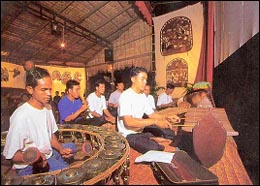
The pin peat is a predominant percussion
orchestra, which is most common with the
shadow theatre, court dance, all-male dance-drama,
and temple ceremonies. It usually consist
of the following instruments:
Sralai: quadruple-reed hard hood
or ivory instrument, akin to an oboe.
Roneat ek: High-pitched xylophone
with twenty-one wooden or bamboo keys.
Roneat thung: Low-pitched xylophone
with sixteen wooden or bamboo keys.
Roneat dek: xylophone with twenty-one
steel keys.
Kong Thom: Low-pitched circle of
sixteen knobbed gongs set within a large
rattan frame.
Kong Touc: Similar to kong thom,
but with smaller gongs and frame, and a
higher pitch.
Samph : double-headed barrel drum
mounted horizontally on a stand; heads covered
with calf skin and played with the hands.
Skor thom: large pair of barrel drums
held in tilted position on stands; head
covered with cow skin; sounded with mallets.
Chheung: small handheld brass cymbals.
The mohori orchestra, combining strings
with wind and percussion instruments plays
folks or entertainment music. The instruments
usually found in this ensemble are;
Roneat ek: High-pitched xylophone
with twenty-one wooden or bamboo keys.
Roneat thung: Low-pitched xylophone
with sixteen wooden or bamboo keys.
Chheung: small handheld brass cymbals.
Khloy: Bamboo flute.
Tro Chhe: high-pitched, two-strings
fiddle with cylindrical resonating box made
from wood, ivory or buffalo horn.
Tro Sau: Two-stringed fiddles with
cylindrical resonating box made from wood,
bamboo, ivory, or buffalo horn and covered
with snakeskin.
Tro Ou: two-stringed fiddle with
resonating box made from a coconut shell.
Krapeu or Takhe: wooden, three-stringed
plucked zither; in shape of crocodile.
Khim: Hammered dulcimer
Thaun rumanea: pair of drums; one goblet
drum made from clay or wood with calf or
snake skin head and one shallow frame drum;
may replace skor areak.
Skor areak: goblet drum made from
wood or clay; head covered with snakeskin;
may replace thaun rumanea.
Other instruments;
Pey Bobos or Pey: bamboo flute with
double reed.
Ploy: mouth organ fashioned from
a gourd with bamboo pipes.
 DANCES
IN CAMBODIA DANCES
IN CAMBODIA |
Dance in Cambodia is as ancient as the
temples of Angkor. Indeed, many of the temples
in the Angkor complex are decorated with
Apsara dancers carved in bas-relief; a single
gallery in Angkor Wat alone features over
1,500 of them. The word Apsara derives,
like much of the culture of ancient Angkor,
from Indian Hindu influences. Apsaras were
lesser goddesses of unimaginable beauty,
born of a sea of churning milk, whose job
it was to dance for the entertainment of
higher gods. The term "apsara dance"
today is interchangeable with court dance
and classical dance. All refer to the form
of dancing and musical accompaniment that
formed a central part of the culture of
the Khmer Empire from its establishment,
during the 9th century AD until its decline
400 years later. Some scholars argue that
there was evidence of classical dance as
long ago as the 1st century.
During the 12th century reign of Jayavarman
VII, over 3,000 dancers are said to have
performed at the Royal Court. The dances
were mostly based on stories taken from
the Hindu epic the Ramayana, and the dancers
were trained, as they are now, to perform
four parts: Neang (the male lead), Neang
Rong (the male lead), Yeaksa (the giant)
and Svar (the monkey). Originally all these
parts where performed by women, until men
began to perform the monkey role in the
final century of the Empire. The dancers
originally performed topless, and so they
are often depicted in bas-relief. It was
only due to later Chinese influence that
they began performing clothed. The dances
feature over 4,500 body movements known
in Khmer as kbach. A pin peat ensemble provides
musical accompaniment alongside singers
who narrate the stories.
 APSARA
DANCE (Court / Classical Dance) APSARA
DANCE (Court / Classical Dance) |
One of the major forms of Khmer dancing,
Apsara dance incorporates parts of other,
much older forms of traditional dance with
its roots in animism and primitive magic,
with Hindu forms introduced in the 1st century.
Classical dance took on its own unique form,
adding movements and meaning, during the
reigns of Kings Jayavarman I to VII.
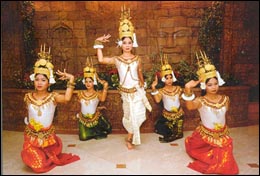
At the heart of classical dance are the
graceful movements of the Apsara dancers,
adorned with gold headdresses and silken
tunics and skirts, as seen carved on the
walls of many of the temples at Angkor.
Estimates are that there were 3,000 Apsara
dancers in the 12th century court of King
Jayavarman VII.
|
Over the centuries
Khmer dancing lent its influence to the classical
ballet of neighboring countries, and some
of its postures and movements are similar
to other Southeast Asian dance forms. Apsara
dancing is one of two elements of classical
ballet. There are four typical roles in Khmer
dance: male, female, giant and monkey; the
first three being the domain of women and
girls, leaving the monkey roles to the men.
In the early days it is believed that all
dancers were female. Most of the dancers in
the Royal Dance Troupe today are female. Dancing
holds great significance for the Khmer people,
and the government considers the Royal Ballet
in particular to be a national treasure.
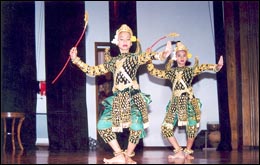
The repertoire of Apsara dances is composed
of dance-dramas representing certain sequences
from the Reamker, other mythical-historical
tales and stories of the lives of Buddha,
as well as exclusively ceremonial dances
and new, shorter pieces.
Stereotyped ideals of social behavior are
communicated in the pure dance as well as
in the narrative pieces. The shyness, gentleness,
and intelligence prized in women, and the
strength and bravery of men are all recognizable
through gesture, story, and facial expression
to a Khmer audience.
 THE
SBACK THOM; CAMBODIAM SHADOW THEATRE THE
SBACK THOM; CAMBODIAM SHADOW THEATRE |
Sback thom means literally "large
leather ", and refers both to the form
of shadow theatre performed in Cambodia
and to the cut-out leather puppets it employs.
This traditional form of dance is believed
to have come from the ancient Siamese court
in the 15th century, which explains that
is also known as nang sback (nang being
the Siamese word for leather).
The panels used are up to 1 square meter
and these differentiate the Sback Thom from
other forms of shadow theatre. These panels
are attached to one or two vertical wooden
rods, which lend support, and serve as handles
with which the player manipulates the sback
above is head. Which also distinguishes
the sback thom from other shadow theater
is the complementary dancing of the players,
which contributes to the dancing character
of the sbacks.
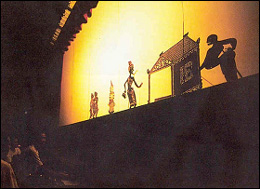
Most of the representations in the Sback
thom take its sources in the Reamker, one
of the earliest known literary works to
have been composed in Khmer, which is in
fact a Khmer version of the Indian Ramayana.
It is thought to have been a sort of libretto
for dramatic performances, and the Sback
thom is entirely dedicated to representations
of episodes of this epic tale. It is usually
performed at open space with no raised stage.
 CEREMONIAL
AND THEATRICAL FOLK DANCES CEREMONIAL
AND THEATRICAL FOLK DANCES |
Ceremonial and theatrical folk dances distinguish
themselves from court dances in terms of
story line, costuming, and performance setting.
The ceremonial dances, as indicated, are
representations of ceremonial folk dances,
including dances still performed as part
of ritual celebrations today. The Theatrical
folk dances, are mostly inspired from daily
activities in the countryside, and also
cover urban interpretation and adaptation
of ritual performances.
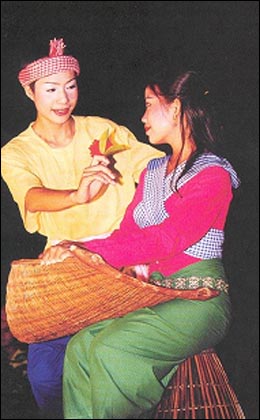
Where to go to see them perform;
National Theatre Performances at:
Royal University of Fine Arts North Campus
Theatre Street 70 (Next to the old Stadium)
Phnom Penh
Tickets: 3,000 riel. Available at the door
or from the UNESCO office (opposite the
National Museum).
Sunrise Children's village
www.sunrisechildrensvillage.com
geraldine.cox@bigpond.com.kh
Tel. 012 803 069; 012 850 752
Visitors are welcome by prior appointment.
The dance troupe is also available for hire
for private functions.
Sovanna Phum
11 Street 360 (corner 105), Phnom Penh
Tel. 012 846 020; 012 857 437
art@sovannaphum.com
Tickets: $4. Performances every Wednesday
and Friday night at 7.30pm.
Grand Hotel d'Angkor
1 Vithei Charles De Gaulle, Siem Reap
Tel. 063 963 888
www.raffles.com
Tickets: $16. Performances every Monday,
Wednesday and Saturday at (9.00pm.)
Special thanks to the Ministry of Tourism
of Cambodia
which has provided part of the editorial
to produce this report.
|

